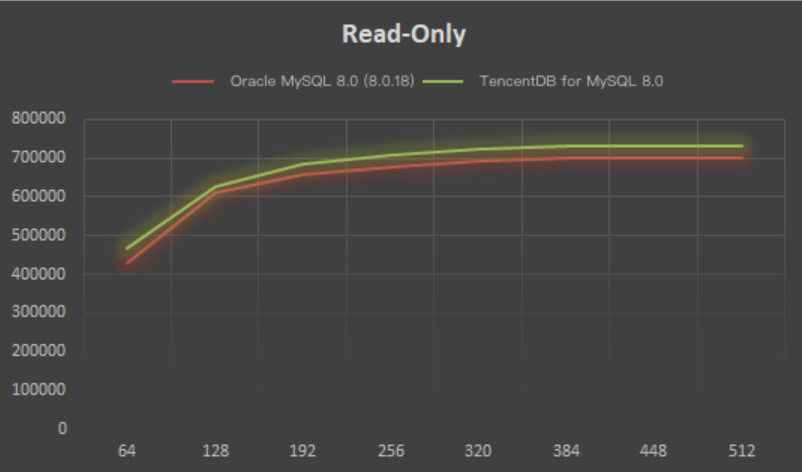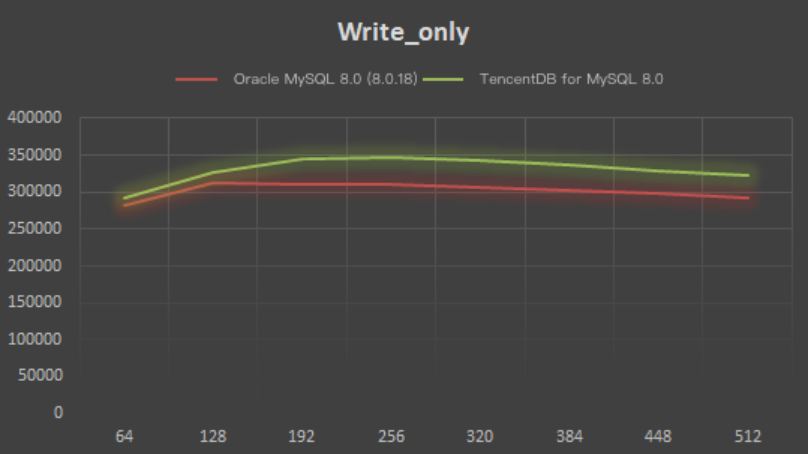Database Versions
Last updated: 2025-05-27 12:46:22
Supported Versions
Currently, TencentDB for MySQL supports MySQL 5.5, 5.6, 5.7, and 8.0. For more information on the features of each version, see Lifetime Support Policy: Coverage of Technology (Oracle MySQL Releases). MySQL's official lifecycle service support policies are as shown below:
Release | GA Date | Premier Support End | Extended Support End | Sustaining Support End |
MySQL Database5.6 | Feb 2013 | Feb 2018 | Feb 2021 | Indefinite |
MySQL Database5.7 | Oct 2015 | Oct 2020 | Oct 2023 | Indefinite |
MySQL Database8.0 | Apr 2018 | Apr 2025 | Apr 2026 | Indefinite |
Note:
The extended official support for MySQL 5.5 ended in December 2018. There has been no explicit statement on further support extension, which is possibly because fixing issues takes more time. We strongly recommend that you use a higher version of MySQL.
MySQL 5.6 and higher no longer support the MyISAM storage engine, so we recommend that you use the InnoDB engine, which features better and more stable performance.
Currently, MySQL 5.6 and higher support three replication modes: async, semi-sync, and strong sync. Only async mode is available in MySQL 5.5.
TencentDB for MySQL will extend support for MySQL 5.7 until after October 2023. During the extension period, important patch updates, upgrade capabilities and service support will still be provided regularly. We will prioritize the availability, reliability and security of our database services.
TencentDB for MySQL Version Lifecycle Description
TencentDB for MySQL is a high-performance enterprise-level database service developed by Tencent Cloud based on open-source MySQL. The lifecycle of all its versions is not limited by the lifecycle in the open-source community but is independently maintained and managed by the Tencent Cloud database team. To ensure business stability, please plan your upgrade schedule based on the TencentDB for MySQL version support policy and upgrade to supported versions promptly.
TencentDB for MySQL Version Support Policies
Note:
The Tencent Cloud support end date indicates that kernel minor version optimizations for this version are no longer implemented after this date. Customers who are using the corresponding version can still use the version or upgrade to a later version for the latest kernel minor version optimizations. For updates of each kernel minor version, see TXSQL Engine Kernel Version Release Notes.
TencentDB for MySQL Version Support Policy
Version | Tencent Cloud Support Start Date | Tencent Cloud Support End Date | Community Deactivation Date |
MySQL 5.6 | March 2016 | March 2022 | February 2021 |
MySQL 5.7 | June 2017 | September 2028 | October 2023 |
MySQL 8.0 | August 2020 | - | April 2026 |
List of Feature Differences between MySQL8.0 and MySQL5.7
Note:
The table below only lists some important differences between MySQL 8.0 and MySQL 5.7. For specific differences, see the official documentation.
Feature | MySQL5.7 | MySQL8.0 |
GRANT ... IDENTIFIED BY PASSWORD Syntax | Supported | Not Supported |
PASSWORD() Function, such as SET PASSWORD ... = PASSWORD('auth_string') | Supported | Not Supported |
Parameters of the SQL_MODE system variable: DB2, MAXDB, MSSQL, MYSQL323, MYSQL40, ORACLE, POSTGRESQL, NO_FIELD_OPTIONS, NO_KEY_OPTIONS, NO_TABLE_OPTIONS, PAD_CHAR_TO_FULL_LENGTH, NO_AUTO_CREATE_USER | Supported | Not Supported |
GROUP BY syntax automatically sorts by default | Supported | Not Supported |
Functions such as ENCODE(), DECODE(), ENCRYPT(), DES_ENCRYPT(), DES_DECRYPT() for encryption and decryption | Supported | Not Supported |
| Supported | Not Supported |
Functions that previously accepted strings or geometric parameters as WKB values no longer permit geometric parameters. For more information, see the official documentation. | Supported | Not Supported |
The parser interprets \\N as NULL. | Supported | Not Supported |
PROCEDURE ANALYSE() Function | Supported | Not Supported |
InnoDB Compressed Temporary Tables | Supported | Not Supported |
JSON_APPEND(), JSON_MERGE() Features | Supported | Not Supported |
| Supported | Not Supported |
Counters for undo_truncate_sweep_count, undo_truncate_sweep_usec, undo_truncate_flush_count, and undo_truncate_flush_usec. | Supported | Not Supported |
Numeric data type ZEROFILL. | Supported | Not Supported |
information_schema_stats_expiry | Supported | Not Supported |
Query Cache | Supported | Not Supported |
The GLOBAL_VARIABLES, SESSION_VARIABLES, GLOBAL_STATUS, SESSION_STATUS tables in the INFORMATION_SCHEMA library, see the official documentation. | Supported | Not Supported |
The INNODB_LOCKS and INNODB_LOCK_WAITS tables in the INFORMATION_SCHEMA library | Supported | Not Supported |
Parallel Query | Not Supported | Supported |
sort merge join | Not Supported | Supported |
statement outline | Not Supported | Supported |
REVOKE supports the IF EXISTS and IGNORE UNKNOWN USER options | Not Supported | Supported |
Supports atomic DDL, ensuring that DDL operations are either fully committed or rolled back. For more information, see the official documentation. | Not Supported | Supported |
TencentDB for MySQL 8.0 Strengths
Combined with a complete set of management services and the TXSQL kernel, TencentDB for MySQL provides an enterprise-level database service that is more stable and quicker to deploy. It applies to various use cases and helps you upgrade your business.
TXSQL is 100% compatible with MySQL and the widely-used MySQL forks.
TencentDB for MySQL supports three disaster recovery systems including hot standby, cold standby, and multi-AZ switchover. It can achieve up to 99.99% service availability and up to 99.9999999% data reliability.
TencentDB for MySQL offers a series of easy-to-use database management services, including monitoring, backup, rollback, encryption, auto scaling, auditing, and intelligent diagnosis and optimization. With these services, you can focus more on your business development.
A TencentDB for MySQL instance can handle 500,000+ QPS, remarkably simplifying both business development and database operations. It reduces the complexity of business architectures, allowing for effortless management through the Database Management Center (DMC).A TencentDB for MySQL instance can handle 500,000+ QPS. TencentDB for MySQL greatly simplifies business development, database Ops, and business architecture, making it easy for you to manage databases.
Several architectures are provided, including single-node, two-node, three-node, and Cluster Edition.
Feature Comparison between TencentDB for MySQL 8.0 and Oracle MySQL 8.0.
Feature | TencentDB for MySQL 8.0 | Oracle MySQL 8.0 |
Cost Performance | 1. Elastic resources. 2. Tencent's kernel TXSQL. 3. Integrated backup and restoration features. 4. A complete set of SaaS tools and services. | 1. Huge one-time investment cost. 2. The open source version has no performance optimization. 3. Additional backup resources and costs. 4. Public network fees and high domain name fees. |
Availability | 1. A complete high-availability switchover system is provided. 2. Read-only instances automatically balance load and traffic. 3. Disaster recovery instances are provided for remote disaster recovery, ensuring high availability. | 1. You need to buy servers and wait for the delivery. 2. You need to deploy the high availability and load balancing systems by yourself. 3. It costs a lot to build data centers in multiple regions. |
Reliability | 1. Data reliability of up to 99.9999999%. 2. Low RPO/RTO. 3. Stable source-replica data replication. | 1. Data reliability of 99%, which depends on the probability of damage to a single disk. 2. You need extra R&D investment to achieve a low RPO. 3. Data replication delays or interruptions may occur. |
Ease of Use | 1. A complete set of database management services are provided and databases can be easily operated in the console. 2. Second-level monitoring and intelligent alarms. 3. Automatic multi-AZ high-availability capability. 4. One-click version upgrade. | 1. You need to deploy high availability and backup and restoration systems by yourself, which requires time and money. 2. You need extra investment to purchase a monitoring system. 3. It costs a lot to set up data centers in different regions with labor costs in Ops. 4. The version upgrade cost is high and the maintenance needs a long downtime. |
Performance | 1. Local SSD disks have excellent performance and the custom hardware supports fast iterations. 2. The optimized TXSQL ensures high performance. 3. DBbrain supports the intelligent diagnosis and optimization of MySQL. | 1. Oracle MySQL has a slower hardware iteration speed than that of cloud computing, usually resulting in lower performance. 2. It can be costly as database maintenance relies on senior DBAs. 3. Oracle MySQL does not have native performance tools, so you have to purchase or deploy them by yourself. |
Security | 1. Prevention in advance: allowlist, security group, VPC-based isolation. 2. Protection during the database operations: TDE + KMS data encryption. 3. Auditing after the database operations: SQL auditing. 4. TencentDB for MySQL is updated right after the Oracle MySQL has security updates. | 1. The cost of the allowlist configuration is high and the private network needs to be implemented by yourself. 2. You need to implement encryption by yourself during the database operations. 3. It is difficult to audit SQLs after the database operations as the open-source MySQL does not support SQL auditing. 4. Once MySQL updates, Ops will be required to install updates or databases will have to be shut down for maintenance. |
Performance Comparison between TencentDB for MySQL 8.0 and Oracle MySQL 8.0
Read Performance

Write Performance

FAQs
What will happen to the TencentDB for MySQL service after the MySQL Community Edition is deactivated?
After the MySQL Community Edition is decommissioned, TencentDB for MySQL will continue to make security fixes for the database version during the extended service period, but will only fix major bugs and security issues. Also continue to perform regular maintenance on hosts, OS, containers, and other service-related components. However, if there are issues related to technical support for the MySQL database version, we may be unable to provide relevant technical support, and you will need to upgrade the database version to receive effective technical support services. Please note that the SLA only applies to issues related to TencentDB for MySQL services and does not cover any failure issues caused by bugs related to the database engine.
How do I upgrade the TencentDB for MySQL version?
TencentDB for MySQL supports upgrading the database version through the console. For more information, see:
Was this page helpful?
You can also Contact Sales or Submit a Ticket for help.
Yes
No
Feedback

